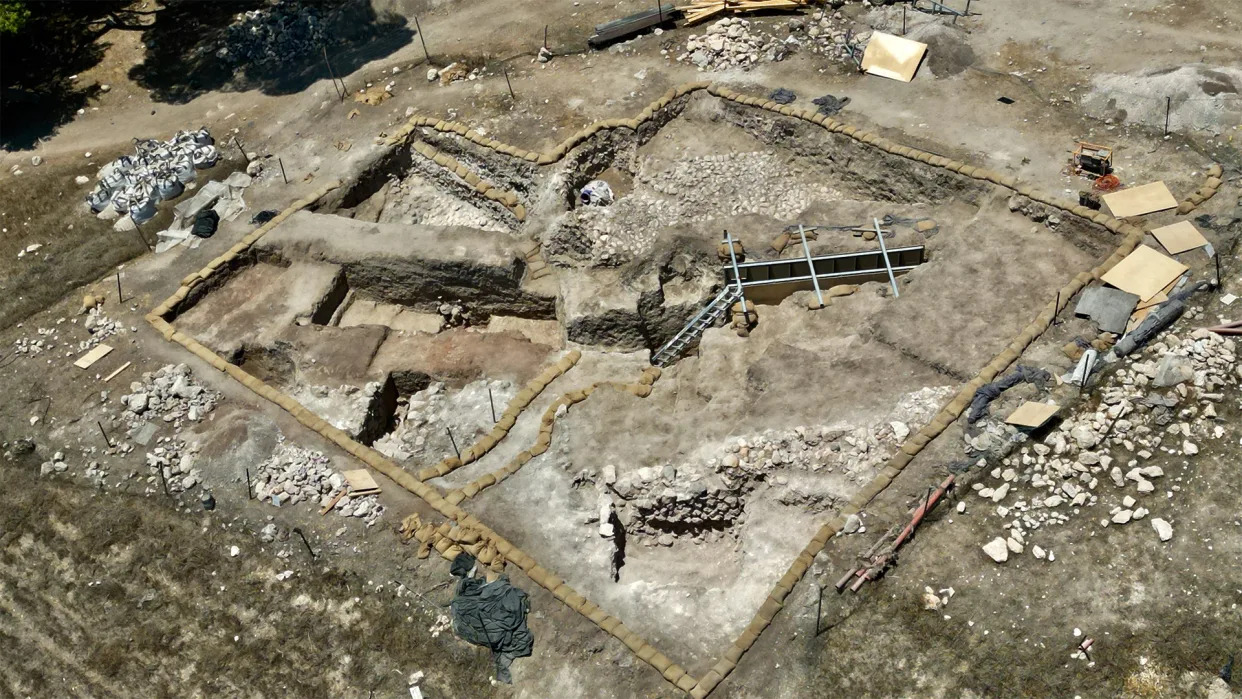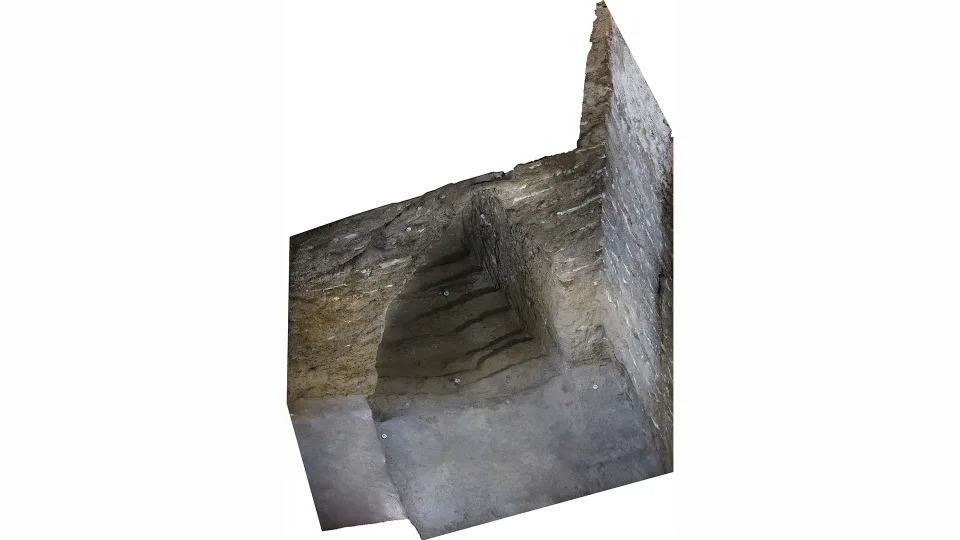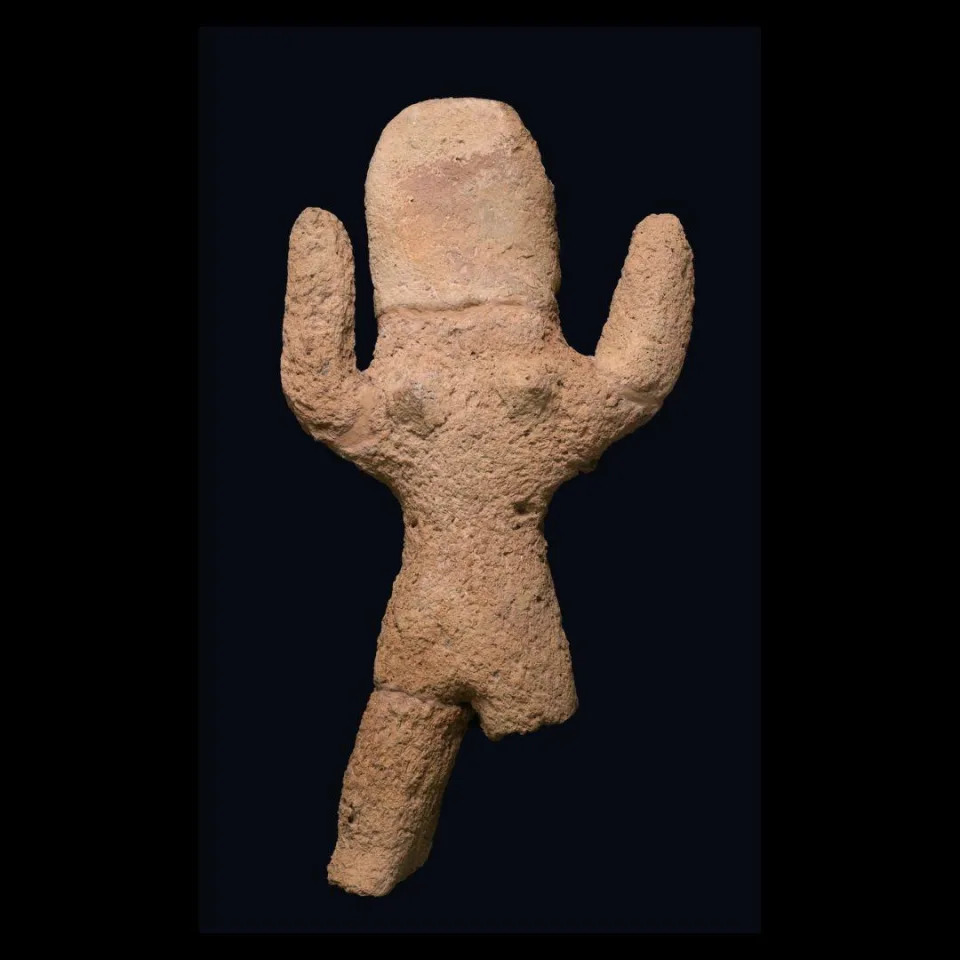No one 'expected to find what we did': 4,000-year-old Canaanite arch in Israel may have been used by cult
Sascha Pare
Thu, September 14, 2023

Photograph of an aerial view of an archaeological site and an excavated steel structure.
Archaeologists in Israel have unearthed a mysterious Canaanite arch and vaulted stairway sealed inside a well-preserved mud brick building that dates to 3,800 years ago, during the Middle Bronze Age. The archaeologists have no idea why the arch was built.
The team had previously excavated a long corridor leading to the arch and stairway at the archaeological site of Tel Shimron, but they were blown away by the preservation of the newfound structures, calling them "breathtaking, especially since the building material is unfired (!) mud brick — a material that only rarely survives a long time," Mario A.S. Martin, co-director of the excavation at Tel Shimron and an archaeologist at the University of Innsbruck in Austria, told Live Science in an email.

Photograph of mudbrick stairs through narrow passageway.
"Of course you never know what you find at a site that has never been excavated, but I can say with confidence that nobody … expected to find what we did," Martin added.
The arch is corbelled, meaning the vault was created by offsetting bricks like an inverted staircase rather than with wedge-shaped stones, which are typically used to build "true" arches. This so-called "false" arch and stairway stands more than 16 feet (5 meters) tall and includes around 9,000 bricks, Martin said.
The ancient Mesopotamins are known for using bricks to make such corbelled construction, but it's never been found in the southern Levant, the region east of the Mediterranean, from this time, he said.
Not long after the corridor and stairway were built — only about one or two generations — ancient workers backfilled both with sediment. However, it's unclear why these structures were sealed off, and it deepens the mystery as to why the Canaanites erected it in the first place.
"Why the passage went out of use so soon is a matter of speculation, fact is that it was done with full intent, and not because there was some imminent danger of collapse," Martin said. "For us archaeologists, the quick backfill is the most lucky piece of the whole story, since it is the only reason the feature is so incredibly well preserved almost 4,000 years later."
Related: Blood-red walls of Roman amphitheater unearthed near 'Armageddon' in Israel

A clay bowl object with various circular containers.
The Canaanites lived in the southern Levant between 3,000 and 4,000 years ago. There is no evidence to suggest the Canaanites were ever united politically or ethnically as a single kingdom, Ann Killebrew, an archaeologist and associate professor at Penn State University, wrote in her book "Biblical Peoples and Ethnicity: An Archaeological Study of Egyptians, Canaanites, Philistines, And Early Israel 1300-1100 B.C.E." (Society of Biblical Literature, 2005).
"Canaan was not made up of a single 'ethnic' group but consisted of a population whose diversity may be hinted at by the great variety of burial customs and cultic structures," Killebrew wrote.
The newly excavated building, which sits within the ancient acropolis of Tel Shimron in the fertile Jezreel Valley, may have served a cultic function, archaeologists told the Israeli newspaper Haaretz. Inside the passageway and before a sharp left turn that leads to the monumental arch, they discovered a seven-cupped pottery artifact known as a Nahariya bowl, which was used for ritual offerings in the Middle Bronze Age.
Other clues hint at cultic traditions within Tel Shimron, which sprawled across the top of a hill and was surrounded by massive ramparts during its heyday. Previous excavations of another mud brick structure within the acropolis uncovered 30,000 bones belonging to animals that were likely sacrificed, the archaeologists said.

A photomosaic of a vaulted passageway with round arched entryways and a staircase.
Having dug their way past the arch, archaeologists came upon stairs leading deeper underground and beyond the building's walls. The stairway could take years to excavate, they said, because it likely extends beneath other fragile Bronze Age ruins that might collapse if they remove the soil.
"We will only understand the full significance of the corridor and the vaulted passageway (and where it exactly leads to), once we excavate more of the environs and beyond the blocked staircase," Martin told Live Science.
Until they find a way to safely excavate the enigmatic stairway, archaeologists have reburied the passageway and arch to protect them from damage.
Artifacts found in Israel were used by "sorcerers" in "rituals" centuries ago
Kerry Breen
Thu, September 14, 2023
Israeli researchers have uncovered artifacts that "professional sorcerers" used in "magical rituals" hundreds of years ago, the Israel Antiquities Authority said in a news release.
The professional sorcerers would have been visited by Muslim pilgrims traveling from Cairo in Egypt to the city of Mecca in the Arabian Peninsula. The rituals would include attempts to ward off the "evil eye," heal diseases and more. The three researchers on the project said in a joint statement that the discovery shows that "people in the Early Ottoman Period — just as today — consulted popular sorcerers, alongside the formal belief in the official religion."

The excavation area in the Eilat Hills. / Credit: Itamar Taxel, Israel Antiquities Authority
"This is the first time that such a large assemblage of ritual objects of this kind has been found," the researchers — Itamar Taxel of the Israel Antiquities Authority, Uzi Avner of the Dead Sea-Arava Science Center and Nitzan Amitai-Preiss of the Hebrew University of Jerusalem — said in the news release.

A clay female figurine. / Credit: Israel Antiquities Authority
The artifacts were discovered in the late 1990s, at an archaeological site in Southern Israel's Eilat Hills. The finds included "dozens of fragments of clay globular rattles, mostly like table tennis balls, containing small stones, that sound when the rattle was shaken" and "two artifacts like miniature votive incense altars, a small figurine of a naked woman or a goddess with raised hands, a characteristic feature of deities or priests, a few other figurines, and colored quartz pebbles." The items were found broken, which the researchers said might have been intentional and done during the ritual ceremonies. An analysis of the clay the items were made of showed that they came from Egypt.

Colored quartz pebbles. / Credit: Clara Amit, Israel Antiquities Authority
The artifacts were found along the Pilgrimage Road, also known in Arabic as the Darb al-Hajj, which ran from Cairo to the Arabian Peninsula. Camping sites and structures have also been found along the route in the same area the artifacts were found. Researchers believe these areas began to be used in the thirteenth or fourteenth centuries.

A clay incense altar. / Credit: Clara Amit, Israel Antiquities Authority
"The find-spot of these artifacts next to the camping site, and the comparison of the artifacts to those known in the Muslim world, as well as the fact that these artifacts were found together as a group, lead to the understanding that they were used in magical rituals," the researchers said. "It seems that these rituals were carried out at the site by one or several people who specialized in popular magical ceremonies."
Kerry Breen
Thu, September 14, 2023
Israeli researchers have uncovered artifacts that "professional sorcerers" used in "magical rituals" hundreds of years ago, the Israel Antiquities Authority said in a news release.
The professional sorcerers would have been visited by Muslim pilgrims traveling from Cairo in Egypt to the city of Mecca in the Arabian Peninsula. The rituals would include attempts to ward off the "evil eye," heal diseases and more. The three researchers on the project said in a joint statement that the discovery shows that "people in the Early Ottoman Period — just as today — consulted popular sorcerers, alongside the formal belief in the official religion."

The excavation area in the Eilat Hills. / Credit: Itamar Taxel, Israel Antiquities Authority
"This is the first time that such a large assemblage of ritual objects of this kind has been found," the researchers — Itamar Taxel of the Israel Antiquities Authority, Uzi Avner of the Dead Sea-Arava Science Center and Nitzan Amitai-Preiss of the Hebrew University of Jerusalem — said in the news release.

A clay female figurine. / Credit: Israel Antiquities Authority
The artifacts were discovered in the late 1990s, at an archaeological site in Southern Israel's Eilat Hills. The finds included "dozens of fragments of clay globular rattles, mostly like table tennis balls, containing small stones, that sound when the rattle was shaken" and "two artifacts like miniature votive incense altars, a small figurine of a naked woman or a goddess with raised hands, a characteristic feature of deities or priests, a few other figurines, and colored quartz pebbles." The items were found broken, which the researchers said might have been intentional and done during the ritual ceremonies. An analysis of the clay the items were made of showed that they came from Egypt.

Colored quartz pebbles. / Credit: Clara Amit, Israel Antiquities Authority
The artifacts were found along the Pilgrimage Road, also known in Arabic as the Darb al-Hajj, which ran from Cairo to the Arabian Peninsula. Camping sites and structures have also been found along the route in the same area the artifacts were found. Researchers believe these areas began to be used in the thirteenth or fourteenth centuries.

A clay incense altar. / Credit: Clara Amit, Israel Antiquities Authority
"The find-spot of these artifacts next to the camping site, and the comparison of the artifacts to those known in the Muslim world, as well as the fact that these artifacts were found together as a group, lead to the understanding that they were used in magical rituals," the researchers said. "It seems that these rituals were carried out at the site by one or several people who specialized in popular magical ceremonies."
No comments:
Post a Comment